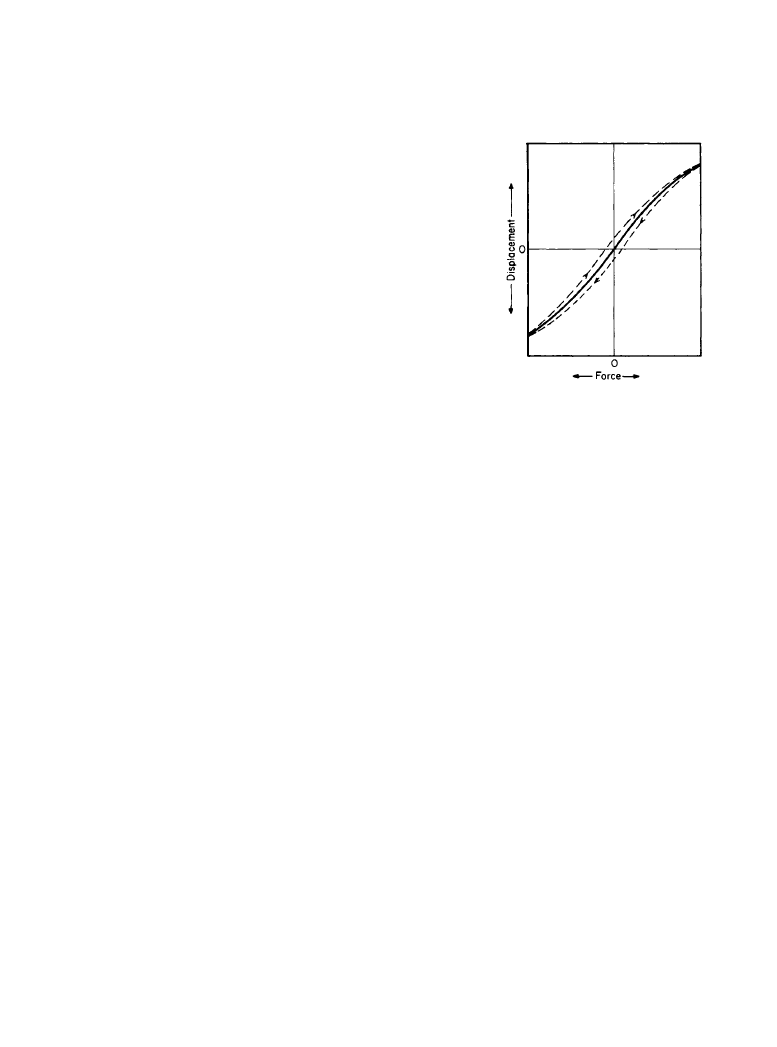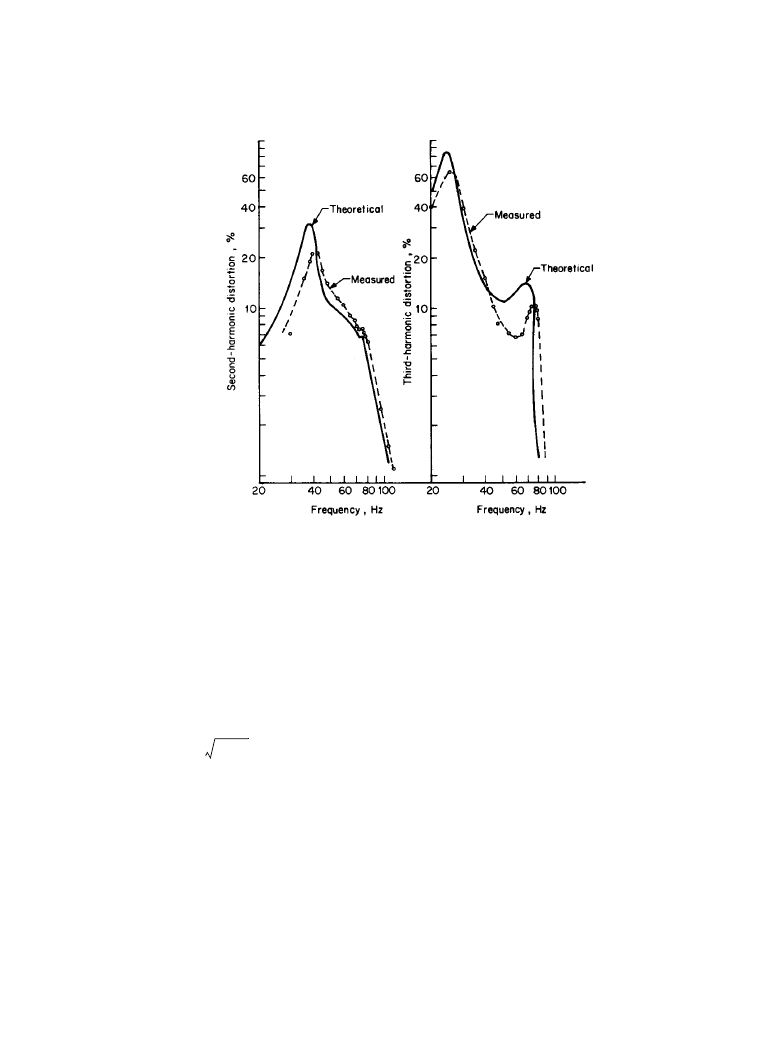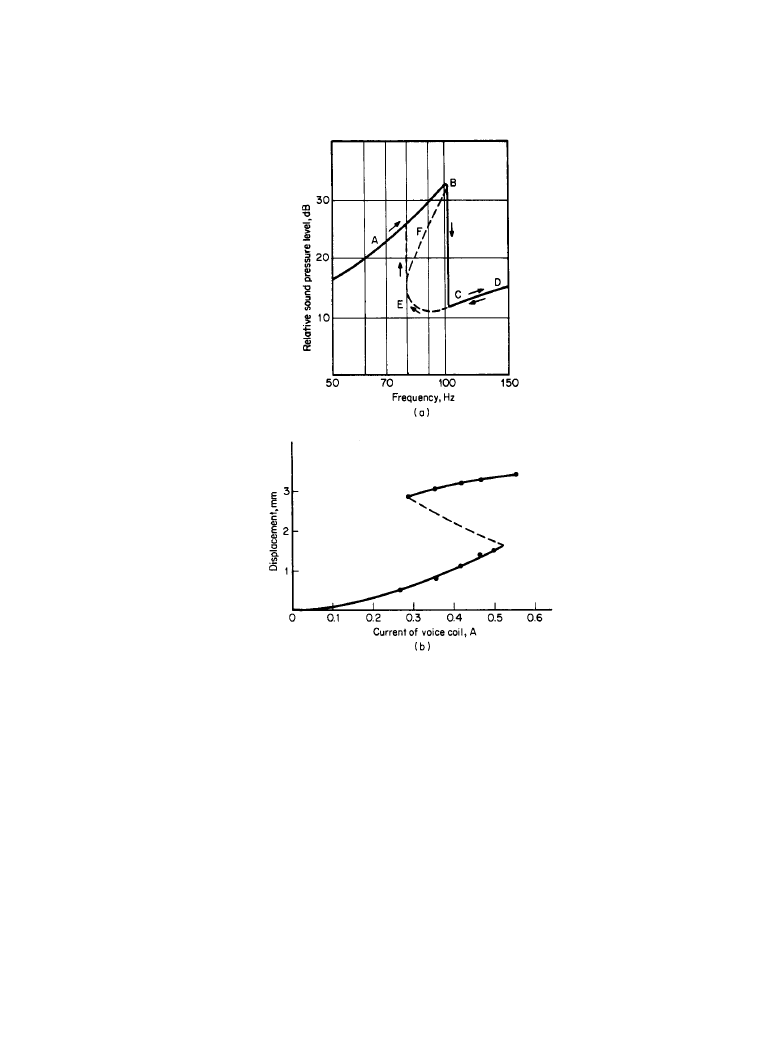ВУЗ: Казахская Национальная Академия Искусств им. Т. Жургенова
Категория: Книга
Дисциплина: Не указана
Добавлен: 03.02.2019
Просмотров: 21674
Скачиваний: 19

Dynamic-Type Direct-Radiation Speakers 5-37
ζ = displacement, m
α, β, γ = constants
Consequently, stiffness
ζ is found by
(5.3.10)
Assuming
ω to be an ultralow frequency with this stiffness function substituted for the basic
equation, Equations (5.3.7) and (5.3.8) are as follows.
(5.3.11)
(5.3.12)
There are several methods of solving this equation. The calculation results on the assumption
that the current is constant, using the indefinite-coefficient method and sample measurements,
are shown in Figure 5.3.13. The point to be considered in the support system in particular is that,
for a large amplitude, suspension elasticity is suddenly lost, forming a cropped wave and leading
to rupture. Because the support system is nonlinear, not only does distortion occur, but a so-
called jumping phenomenon is found. As shown in Figure 5.3.14, amplitude suddenly changes
discontinuously for frequency and current. To prevent this, as large a suspension as possible is
used, and such materials and construction are selected that the center-holding capacity is not
lowered. Cone suspension uses a soft material wherever applicable, and corrugation and ribbing
are provided to avoid edge resonance.
s
ξ
( )
α βξ ϒξ
2
+
+
=
M
MA
d
2
ξ
dt
2
----------
m
d
2
ξ
dt
2
----------
r
d
ξ
dt
-------
s
n
ξ
( )ξ A ξ
( )I ξ
( )
–
+
+
=
E
0
sin
ωt
RI
ξ
( ) A ξ
( )
d
ξ
dt
-------
+
=
Figure 5.3.12
Relation between force and displacement in
a typical suspension.
Downloaded from Digital Engineering Library @ McGraw-Hill (www.digitalengineeringlibrary.com)
Copyright © 2004 The McGraw-Hill Companies. All rights reserved.
Any use is subject to the Terms of Use as given at the website.
Dynamic-Type Direct-Radiation Speakers

5-38 Sound Reproduction Devices and Systems
Air Distortion
Generally, on the assumption that changes in volume are very small when the sound-surge equa-
tion is solved, the secondary or more terms are ignored. However, the smallest distortion cannot
be ignored, and the high-order term cannot be ignored when sound pressure is large. Equation
(5.3.12) shows the degree of second-harmonic wave due to nonlinearity on this high-order term:
(5.3.12)
Where:
p
2
= second-harmonic distorted sound pressure generated by plane waves at distance r, N/m
2
p
r
= fundamental wave sound pressure of plane wave at distance r, N/m
2
p
0
= atmospheric pressure, N/m
γ = ratio between constant-pressure specific heat and constant-volume specific heat (air, 1:4)
ω = angular frequency, rad
c = sound velocity, m/s
r = distance, m
The calculation results of Equation (5.3.12) are shown in Figure 5.3.15.
p
2
ϒ 1
+
(
)ω
2 2
ϒp
0
c
---------------------p
r
2
r
=
Figure 5.3.13
Distortion characteristics of a driving force, calculated from Equations (5.3.11) and
(5.3.12).
Downloaded from Digital Engineering Library @ McGraw-Hill (www.digitalengineeringlibrary.com)
Copyright © 2004 The McGraw-Hill Companies. All rights reserved.
Any use is subject to the Terms of Use as given at the website.
Dynamic-Type Direct-Radiation Speakers

Dynamic-Type Direct-Radiation Speakers 5-39
Frequency-Modulation Distortion
Signals input to a speaker have various frequency spectra. When low- and high-frequency sounds
are radiated from a diaphragm at the same time, high-frequency sound is subjected to modulation
because the diaphragm is moving forward and backward significantly according to low-fre-
quency signals. The frequency-modulated wave generated thereby is expressed by a carrier and
an unlimited number of sideband waves. The mean-square value of the ratio of sideband-wave
energy to all energies of the sound wave is expressed in percentage as follows:
Figure 5.3.14
Nonlinear suspension system: (
a) the unstable portion of the response frequency
characteristic, indicated by the dashed line; (
b) the unstable portion of the response current char-
acteristic, indicated by the dashed line.
Downloaded from Digital Engineering Library @ McGraw-Hill (www.digitalengineeringlibrary.com)
Copyright © 2004 The McGraw-Hill Companies. All rights reserved.
Any use is subject to the Terms of Use as given at the website.
Dynamic-Type Direct-Radiation Speakers

5-40 Sound Reproduction Devices and Systems
(5.3.13)
Where:
D = distortion, percent
f
2
= modulated wave (high-frequency), Hz
f
1
= modulated wave (low-frequency), Hz
p
1
= acoustic output of f
1
, W
d = cone diameter, m
One of the methods for reducing this distortion is to use a multiway speaker system.
D
2900
f
2
p
1
f
1
2
d
2
--------------
=
Figure 5.3.15
The distortion generated in the air gap between the cone and the listening-point dis-
tance in a direct-radiator speaker with a cone diameter of 20 cm, measured at a distance of 3 m.
Downloaded from Digital Engineering Library @ McGraw-Hill (www.digitalengineeringlibrary.com)
Copyright © 2004 The McGraw-Hill Companies. All rights reserved.
Any use is subject to the Terms of Use as given at the website.
Dynamic-Type Direct-Radiation Speakers

Dynamic-Type Direct-Radiation Speakers 5-41
5.3.2d
Diaphragm and Support System
It is no exaggeration to say that the diaphragm and support system nearly determine speaker
acoustic characteristics. A typical shape and features for the diaphragm and support system are
described below.
Diaphragm
Diaphragms are classified by shape into cone, plane, and dome diaphragms. The cone diaphragm
is one of the most frequently used types. Figure 5.3.16 shows some typical shapes. Any of these
types is directed to widening the piston-motion area to enhance a high-range playback limit fre-
quency and also to reduce distortion. For this purpose, it is important to know the vibrating con-
ditions of the cone diaphragm, but it is very difficult to find them analytically.
In the dome diaphragm, a thin metallic foil, resin-impregnated cloth, or paper is formed into a
sphere, and the periphery of the diagram is driven. A diaphragm with a smaller-aperture diame-
ter is easy to realize because of circumferential drive, split vibration can be controlled up to a
high frequency, and favorable directional characteristics are also obtained. Materials used in this
diaphragm include the following:
•
Sulfite cellulose
•
Sulfate pulp
•
Paper mixed with highly elastic fiber such as silicon carbide whiskers, carbon fiber, and ala-
mido fiber
•
Metal foil such as aluminum, titanium, and beryllium
•
High-polymer film such as polyethylene telephthalate or highly elastic materials reinforced
by deposition such as carbon, boron, and beryllium
•
Composite materials using honeycomb and foamed urethane as a core
Support System
The support system is divided broadly into a cone suspension system and a center holder. The
cone suspension system is required to absorb reflection from the frame as a termination of the
diaphragm to control edge resonance and also to prevent an acoustic short circuit which would
occur before and after the diaphragm along with a baffle board. This system must be constructed
so that it is easy to move in the vibrating-axis direction of the diaphragm and difficult to move in
the lateral direction along with the center holder. The principal construction features of the cone
suspension system are shown in Figure 5.3.17. Materials having proper mechanical resistance
are preferable.
Requirements for centering suspension include the following:
•
Provide proper stiffness in order to maintain a restoration force
•
Hold a voice coil in the center of the gap formed by the magnetic circuit in order to smooth
movement in the axial direction
•
Maintain favorable linearity of driving-force-to-displacement characteristics even when the
diaphragm is given large amplitude
Downloaded from Digital Engineering Library @ McGraw-Hill (www.digitalengineeringlibrary.com)
Copyright © 2004 The McGraw-Hill Companies. All rights reserved.
Any use is subject to the Terms of Use as given at the website.
Dynamic-Type Direct-Radiation Speakers